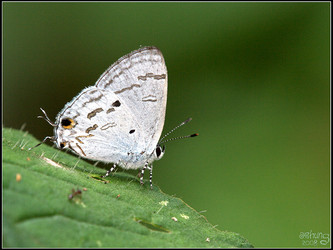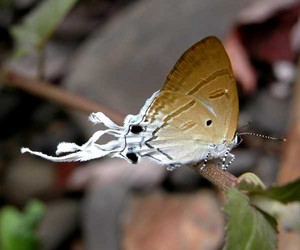Hypolycaenini
Andrew V. Z. Brower


This tree diagram shows the relationships between several groups of organisms.
The root of the current tree connects the organisms featured in this tree to their containing group and the rest of the Tree of Life. The basal branching point in the tree represents the ancestor of the other groups in the tree. This ancestor diversified over time into several descendent subgroups, which are represented as internal nodes and terminal taxa to the right.

You can click on the root to travel down the Tree of Life all the way to the root of all Life, and you can click on the names of descendent subgroups to travel up the Tree of Life all the way to individual species.
For more information on ToL tree formatting, please see Interpreting the Tree or Classification. To learn more about phylogenetic trees, please visit our Phylogenetic Biology pages.
close boxIntroduction
A tribe distributed in the African and Oriental regions. Some authors regard Hypolycaena, Chliaria and Zeltus as congeneric. Larsen (1991) argued that the Madagascan-east African genus Hemiolaus belongs in Hypolycaenina, based on morphology, behavior and larval host plants that unite it with other members of the tribe.
References
Bridges CA. 1988. Catalogue of family-group and genus-group names (Lepidoptera: Rhopalocera). Charles A. Bridges, Urbana, IL.
Eliot JN. 1973. The higher classification of the Lycaenidae (Lepidoptera): a tentative arrangement. Bull. Br. Mus. Nat. Hist. (Ent.) 28: 371-505, 6 pls.
Larsen, T. B. 1991 The butterflies of Kenya and their natural history. Oxford, U. K.: Oxford University Press.
Title Illustrations

| Scientific Name | Chliaria kina |
|---|---|
| Location | Taiwan |
| Specimen Condition | Live Specimen |
| Source | 蘭灰蝶(雙尾琉璃小灰蝶)Hypolycaena kina inari (Wileman) |
| Source Collection | Flickr |
| Image Use |
 This media file is licensed under the Creative Commons Attribution-NonCommercial-ShareAlike License - Version 2.0. This media file is licensed under the Creative Commons Attribution-NonCommercial-ShareAlike License - Version 2.0.
|
| Copyright | © 2008 ashung |
| Scientific Name | Zeltus amasa |
|---|---|
| Location | India: Arunachal Pradesh, Jairampur |
| Specimen Condition | Live Specimen |
| Identified By | Andrew V. Z. Brower |
| Life Cycle Stage | adult |
| View | ventral |
| Source | Image:VB_016_FlufyTit.jpg |
| Source Collection | Wikimedia Commons |
| Image Use |
 This media file is licensed under the Creative Commons Attribution-ShareAlike License - Version 2.5. This media file is licensed under the Creative Commons Attribution-ShareAlike License - Version 2.5.
|
| Copyright | © 2006 Vijaybarve |
About This Page
Andrew V. Z. Brower

Middle Tennessee State University, Murfreesboro, Tennessee, USA
Correspondence regarding this page should be directed to Andrew V. Z. Brower at
abrower@mtsu.edu
Page copyright © 2008 Andrew V. Z. Brower
 Page: Tree of Life
Hypolycaenini .
Authored by
Andrew V. Z. Brower.
The TEXT of this page is licensed under the
Creative Commons Attribution License - Version 3.0. Note that images and other media
featured on this page are each governed by their own license, and they may or may not be available
for reuse. Click on an image or a media link to access the media data window, which provides the
relevant licensing information. For the general terms and conditions of ToL material reuse and
redistribution, please see the Tree of Life Copyright
Policies.
Page: Tree of Life
Hypolycaenini .
Authored by
Andrew V. Z. Brower.
The TEXT of this page is licensed under the
Creative Commons Attribution License - Version 3.0. Note that images and other media
featured on this page are each governed by their own license, and they may or may not be available
for reuse. Click on an image or a media link to access the media data window, which provides the
relevant licensing information. For the general terms and conditions of ToL material reuse and
redistribution, please see the Tree of Life Copyright
Policies.
- First online 08 April 2008
- Content changed 24 April 2008
Citing this page:
Brower, Andrew V. Z. 2008. Hypolycaenini . Version 24 April 2008 (under construction). http://tolweb.org/Hypolycaenini/111495/2008.04.24 in The Tree of Life Web Project, http://tolweb.org/









 Go to quick links
Go to quick search
Go to navigation for this section of the ToL site
Go to detailed links for the ToL site
Go to quick links
Go to quick search
Go to navigation for this section of the ToL site
Go to detailed links for the ToL site